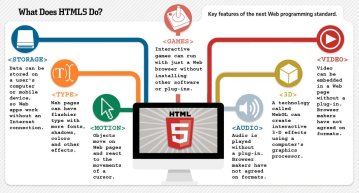Insightful Journeys
Explore a world of knowledge and information.
HTML5: The Unsung Hero of Web Development
Discover how HTML5 transformed web development into a dynamic, interactive experience. Uncover its hidden power today!
Why HTML5 is Essential for Modern Web Development
HTML5 has become a cornerstone of modern web development due to its enhanced features and capabilities that significantly improve user experience. One of the most important aspects of HTML5 is its support for multimedia elements such as audio and video, allowing developers to integrate rich content seamlessly without relying on external plugins. This native support not only enhances the performance of websites but also ensures compatibility across various devices and browsers. Furthermore, with features like the Canvas API, developers can create dynamic graphics and animations, making it easier to deliver engaging content that captures users' attention.
Moreover, HTML5 introduces improved semantic elements such as

Exploring the Key Features of HTML5: What Developers Need to Know
HTML5 is a powerful evolution of the standard markup language for the web, designed to improve the functionality and accessibility of web applications. One of the key features of HTML5 is the introduction of semantic elements, which provide meaning to the structure of web content. Tags such as <article>, <section>, and <nav> help developers create more organized and readable code while enhancing SEO performance. Additionally, multimedia support has been significantly improved with the <video> and <audio> tags, allowing developers to integrate high-quality media without relying on third-party plugins. For more details on the importance of semantic HTML, visit W3Schools.
Another notable feature of HTML5 is the Canvas API, which allows developers to create dynamic, graphics-rich applications directly within the browser. This powerful feature enhances user experience, making it possible to draw graphics, animations, and even manipulate images—all through JavaScript. Furthermore, HTML5 offers new form elements such as <input type='date'> and <input type='email'>, simplifying the process of gathering user data. These advancements demonstrate HTML5’s commitment to evolving web development practices. For further insights on using the Canvas API, refer to MDN Web Docs.
How HTML5 Enhances User Experience: Examples and Best Practices
HTML5 has revolutionized the way websites are built, significantly enhancing the user experience through its streamlined features and functionalities. One major improvement is the introduction of native video and audio support. By allowing the direct integration of media elements, developers can create engaging content without the need for third-party plugins, resulting in faster loading times and smoother playback. Additionally, HTML5 brings forth semantics that improve accessibility and search engine optimization (SEO). For example, using elements like <header>, <footer>, and <article> not only organizes content but also aids search engines in understanding page structure better.
Another noteworthy feature of HTML5 is the Canvas API, which enables dynamic, scriptable rendering of 2D shapes and bitmap images. This allows websites to provide interactive graphics and animations, enhancing the overall user engagement. Furthermore, HTML5 supports local storage, which grants websites the ability to store user data client-side, enhancing performance by reducing server requests. Best practices for leveraging HTML5 for user experience include ensuring compatibility across browsers, using <progress> and <meter> elements for better feedback, and taking advantage of responsive design principles to create layouts that adapt to different devices.